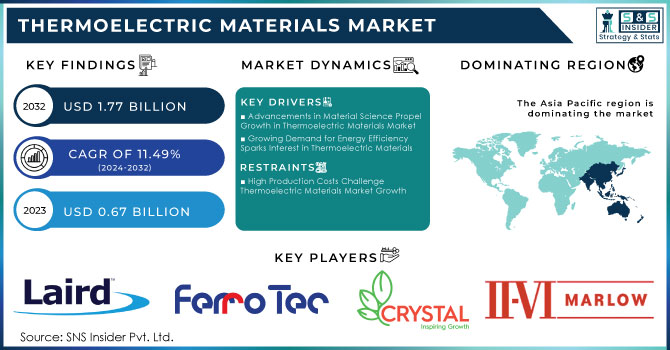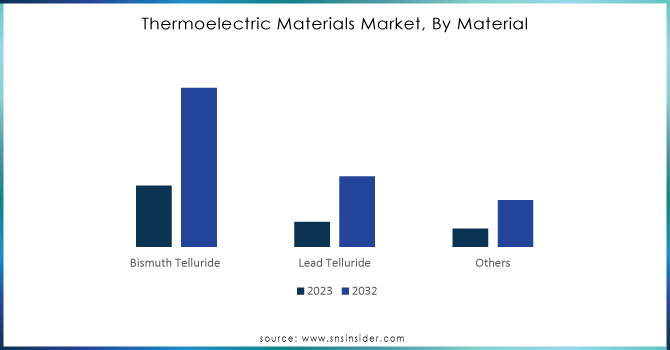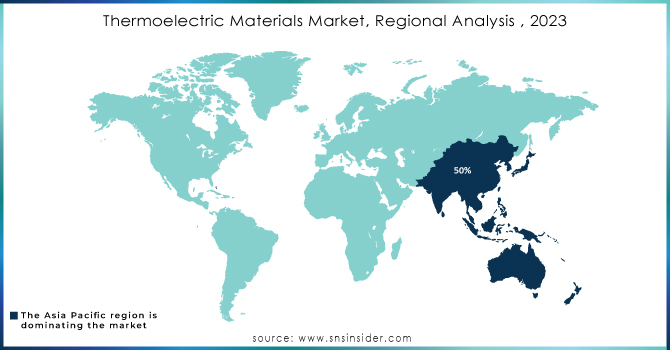Thermoelectric Materials Market Size:

Get More Information on Thermoelectric Materials Market - Request Sample Report
Thermoelectric Materials Market was valued at USD 0.67 billion in 2023 and is expected to reach USD 1.77 billion by 2032, growing at a CAGR of 11.49% from 2024-2032.
In many industries, there is an immediate demand for heat energy waste recovery with thermoelectric materials. Each year about 276 trillion British thermal units (TBtu) of heat is wasted throughout the U.S. from industrial processes that require heat at temperatures greater than 300°F—an even higher value of 1,478 TBtu year-wise when using a reference temperature of 77°F—indicating how significant these losses are and creating a need for efficient recovery solutions where thermoelectric materials may be useful to harvest parts of waste into added energy, making energy processes more effective.
The thermoelectric materials market is expanding as a result of numerous factors. For instance, in the case of the European Union alone, its longstanding and very ambitious climate targets call for at least a 40% share of renewable energy sources in the overall energy mix by 2030 compared to 32%. This change requires new technologies such as thermoelectric materials that can help carry out waste heat utilization in industrial and renewable energy processes. In addition, government expenditure on clean energy projects has increased by more than USD 500 billion since March 2022—bringing the total to over USD 1.2 trillion committed (or spent) so far during the COVID-19 pandemic. These financial commitments demonstrate a strong supportive environment for thermoelectric technologies.
In the long term, developments in thermoelectric materials will likely transform the energy sector. We use novel measurement techniques to demonstrate the enhanced performance of these materials as thermoelectric (TE) devices in terms of their key attributes: thermopower, thermal conductance, and electrical conductivity. The ongoing research and development of high-performance thermoelectric materials are therefore vital to accommodate this growing demand for effective energy solutions, supporting the transition towards a sustainable energy future.
MARKET DYNAMICS
DRIVERS
-
Advancements in Material Science Propel Growth in Thermoelectric Materials Market
This percolation effect improvement should boost the efficiency of the organic materials as thermoelectric materials, resulting in larger performance enhancements. Different nanocomposites synthesized also increase the CO₂ and oxygen photoreduction ability, which can further provide better thermoelectric properties. While this performance was driven by a broad array of low-carbon energy solutions, global investment reached an all-time high of USD 1.77 trillion in 2023, buoyed by electrified transport, renewable energy, and new technologies. China spent USD 676 billion on the measure but was still outdone in total by all EU and US plus U.K. packages combined. These initiatives highlight the growing emphasis on advanced materials that facilitate green energy transitions.
-
Growing Demand for Energy Efficiency Sparks Interest in Thermoelectric Materials
Increasing concern regarding the conservation of energy is one of the key driving force for the growth of the market, as thermoelectric materials are widely used to recover waste heat. More industries are realizing how economically and ecologically beneficial materials that transform excess heat into usable energy can be. This transition will improve efficiency and meet global sustainability objectives. With regulations becoming stricter alongside rising energy costs—with an estimated increase of US energy consumption set to rise nearly 15% by 2050, with monthly gas prices dropping 26.5% and electricity prices 13%—the need for novel solutions is more urgent than ever before. As a result, this commitment towards reduction in carbon footprints implemented by efficient utilization of resources is likely to increase the demand for the thermoelectric materials market significantly as businesses will be more reliant on energy-efficient technologies.
RESTRAINTS
-
High Production Costs Challenge Thermoelectric Materials Market Growth
The manufacturing of high-performance thermoelectric materials is generally limited by a costly fabrication process based on the use of expensive raw materials and/or complicated processing methods. Such financial constraints can discourage investment and hinder their incorporation into applications. The scale needed for production to meet growing market demand can be hindered by the complexity of their construction. With these economic challenges facing manufacturers, the situation calls for novel cost-reduction strategies to make thermoelectric technologies more affordable compared to traditional energy conversion systems. Therefore, the production high cost serves as a major hindrance for the thermoelectric materials market.
SEGMENT ANALYSIS
BY APPLICATION
Waste heat recovery dominated the thermoelectric materials market with approximately 47% of revenue in 2023. This dominance can be attributed to industries being more focused on energy efficiency and sustainability. Captured and converted into usable energy, waste heat is an increasingly vital resource as organizations seek to reduce operational costs and achieve carbon reductions. This also further strengthens such a trend with regulatory frameworks encouraging energy conservation.
Co-generation is expected to grow at the highest CAGR of around 12.65% during 2024–2032. This growth is fueled by the demand for waste heat recovery systems that combine both power and heating generation. One challenge these co-generation systems have is to make use of the same fuel source without producing waste. In addition, the improvement of technology is facilitating easy access to co-generation systems with economic procurement styles across all kinds of sectors.
BY END USE
The IT and telecom sector accounts for a leading share of the thermoelectric materials market, with nearly 28% revenue share in 2023. The industry's endless requirement for cooling solutions as well as energy management systems is the major reason behind this dominance. With the Continuous expansion of data centers and telecom infrastructure, it has become essential to reduce energy consumption as well as handle waste heat. Furthermore, the increasing pressure for sustainability with technology is another factor driving the trend toward thermoelectric materials.
The oil and gas industry is expected to grow over 12.63% CAGR between 2024 and 2032, making it the most vigorous area of growth. A large part of this growth is driven by rising investments in energy efficiency and waste heat recovery systems in the industry. With so many companies looking to distance themselves from traditional methods of operating, and having a level within their administration focus on reducing emissions, thermoelectric materials remain a reliable method of transforming excessive heat into something useful. The rapid development of extraction and processing technologies is pushing for precision thermoelectric applications in this area.
BY MATERIAL
During 2023, bismuth telluride dominated the thermoelectric material market with approximately 59% of revenue. The root cause of this has to do with its unrivaled room-temperature thermoelectric performance, which makes it a very promising candidate for cooling and power generation. Well-developed and available processes for manufacturing make it even more attractive across multiple industries. It is also being researched to optimize its efficiency and extend its applicability.
In contrast, lead telluride is expected to record the highest compound annual growth rate (CAGR) of approximately 12.33% between 2024 and 2032. Much of the growth can be attributed to its much better performance at higher temperatures, which makes it a better fit for industrial applications and waste heat recovery systems. The rising importance of energy efficiency among industries is likely to contribute towards projected growth in the production of lead telluride for high-temperature applications. Lower material processing costs and better technologies are leading to adoption in a broader range of sectors.

Need Any Customization Research On Thermoelectric Materials Market - Inquiry Now
BY MODEL
Single stage dominated the Thermoelectric Materials market with the highest revenue share of about 57% in 2023. The supremacy of these devices is attributed to their simplicity, low-cost manufacturing, and convenience of application. They have also proved that they are especially efficient for low-temperature heat recovery and cooling applications, which makes them appealing at scale to both industrial and consumer markets. That clear history of existence and dependability they have enhanced their title.
While multi-stage thermoelectric systems are expected to follow with the fastest compounded annual growth rate (CAGR) of 12.04% between 2024 and 2032. This growth is driven by the rising requirement of high efficiency and improved performance in energy conversion applications. Multi-stage Derived systems are specifically designed to generate electricity from high-temperature sources which makes them preferable for waste heat recovery and industrial applications. Over time, as industries look for new and original ways to provide energy efficiency at its maximum capacity, multi-stage systems will be adopted more and more strongly.
REGIONAL ANALYSIS
APAC controls about 50% of the entire thermoelectric materials market revenue in 2023. China and India being the fastest-growing industrialized countries, account for their ability to grab this dominance with the help of energy efficiency. Substantial investments and infrastructure supporting renewable energy sources, along with advanced waste heat recovery technologies reinforce regional markets. Moreover, government support for sustainable practices is further driving the market of thermoelectric solutions in multiple industries.
On the other hand, North America will see the highest compound annual growth rate (CAGR), approximately 12.33% during 2024 – 2032. Well, this is because of the surge in investment in clean energy technologies and growing interest in energy efficiency. A well-established R&D infrastructure in the region enables innovation about thermoelectric materials that make these economical and efficient. The growing need for advanced thermoelectric solutions in North America will significantly increase as businesses and governments focus more on sustainability initiatives.

LATEST NEWS-
-
On June 3, 2024, Laird Thermal Systems launched a new generation of high-performance thermoelectric cooler assemblies with next-generation thermoelectric coolers made from advanced semiconductor materials.
-
Published in 2024, a research group created an artificially engineered atomic-scale defect in a bismuth telluride (Bi-Te) thermoelectric material to serve as a hopeful improvement for effective waste thermal energy capture.
KEY PLAYERS
-
Laird Thermal Systems, Inc. (Laird Thermal Solutions, Thermoelectric Modules)
-
Thermonamic Electronics (Jiangxi) Corp., Ltd. (Thermoelectric Generators, Peltier Modules)
-
Ferrotec (USA) Corporation (Thermoelectric Coolers, Thermoelectric Modules)
-
EVERREDtronics Ltd. (Thermoelectric Cooling Solutions, Peltier Elements)
-
Hi-Z Technology (Hi-Z Thermoelectric Modules, Thermoelectric Generators)
-
Crystal Ltd. (Crystal Thermoelectric Modules, Peltier Devices)
-
TEC Microsystems GmbH (TEC Microsystems Peltier Modules, Thermoelectric Generators)
-
Xiamen Hicool Electronics Co., Ltd. (Hicool Peltier Modules, Thermoelectric Cooling Devices)
-
Marlow Industries, Inc. (Marlow Thermoelectric Modules, Thermoelectric Generators)
-
Ferrotec Corporation (Ferrotec Thermoelectric Coolers, Peltier Devices)
-
II-VI Incorporated (II-VI Thermoelectric Modules, Advanced Peltier Solutions)
-
KELK Ltd. (KELK Thermoelectric Devices, Custom Cooling Solutions)
-
RMT Ltd. (RMT Peltier Modules, Thermoelectric Cooling Units)
-
TEGPRO Thermoelectric Generator Company (TEGPRO Thermoelectric Generators, Thermoelectric Power Systems)
-
Kryotherm (Kryotherm Thermoelectric Modules, Advanced Cooling Solutions)
-
Thermion Company (Thermion Thermoelectric Modules, Peltier Devices)
-
Yamaha Corporation (Yamaha Thermoelectric Generators, Cooling Systems)
-
Gentherm Incorporated (Gentherm Thermoelectric Seats, Automotive Thermal Management Systems)
-
Alphabet Energy (Alphabet Energy Generators, Thermoelectric Modules)
| Report Attributes | Details |
|---|---|
| Market Size in 2023 | USD 0.67 Billion |
| Market Size by 2032 | USD 1.77 Billion |
| CAGR | CAGR of 11.49% From 2024 to 2032 |
| Base Year | 2023 |
| Forecast Period | 2024-2032 |
| Historical Data | 2020-2022 |
| Report Scope & Coverage | Market Size, Segments Analysis, Competitive Landscape, Regional Analysis, DROC & SWOT Analysis, Forecast Outlook |
| Key Segments | • By Material (Bismuth Telluride, Lead Telluride, Others) • By Application (Waste Heat Recovery, Energy Harvesting, Direct Power Generation, Co-generation) • By End-use (Consumer Electronics, Manufacturing and Industrial, IT and Telecom, Automotive, Healthcare, Aerospace, Oil and Gas) • By Model (Single Stage, Multi-Stage) |
| Regional Analysis/Coverage | North America (US, Canada, Mexico), Europe (Eastern Europe [Poland, Romania, Hungary, Turkey, Rest of Eastern Europe] Western Europe] Germany, France, UK, Italy, Spain, Netherlands, Switzerland, Austria, Rest of Western Europe]), Asia Pacific (China, India, Japan, South Korea, Vietnam, Singapore, Australia, Rest of Asia Pacific), Middle East & Africa (Middle East [UAE, Egypt, Saudi Arabia, Qatar, Rest of Middle East], Africa [Nigeria, South Africa, Rest of Africa], Latin America (Brazil, Argentina, Colombia, Rest of Latin America) |
| Company Profiles | Laird Thermal Systems, Inc., Thermonamic Electronics (Jiangxi) Corp., Ltd., Ferrotec (USA) Corporation, EVERREDtronics Ltd., Hi-Z Technology, Crystal Ltd., TEC Microsystems GmbH, Xiamen Hicool Electronics Co., Ltd., Marlow Industries, Inc., Ferrotec Corporation, II-VI Incorporated, KELK Ltd., RMT Ltd., TEGPRO Thermoelectric Generator Company, Kryotherm, Thermion Company, Yamaha Corporation, Gentherm Incorporated, Alphabet Energy |
| Key Drivers | • Advancements in Material Science Propel Growth in Thermoelectric Materials Market • Growing Demand for Energy Efficiency Sparks Interest in Thermoelectric Materials |
| Restraints | • High Production Costs Challenge Thermoelectric Materials Market Growth |

